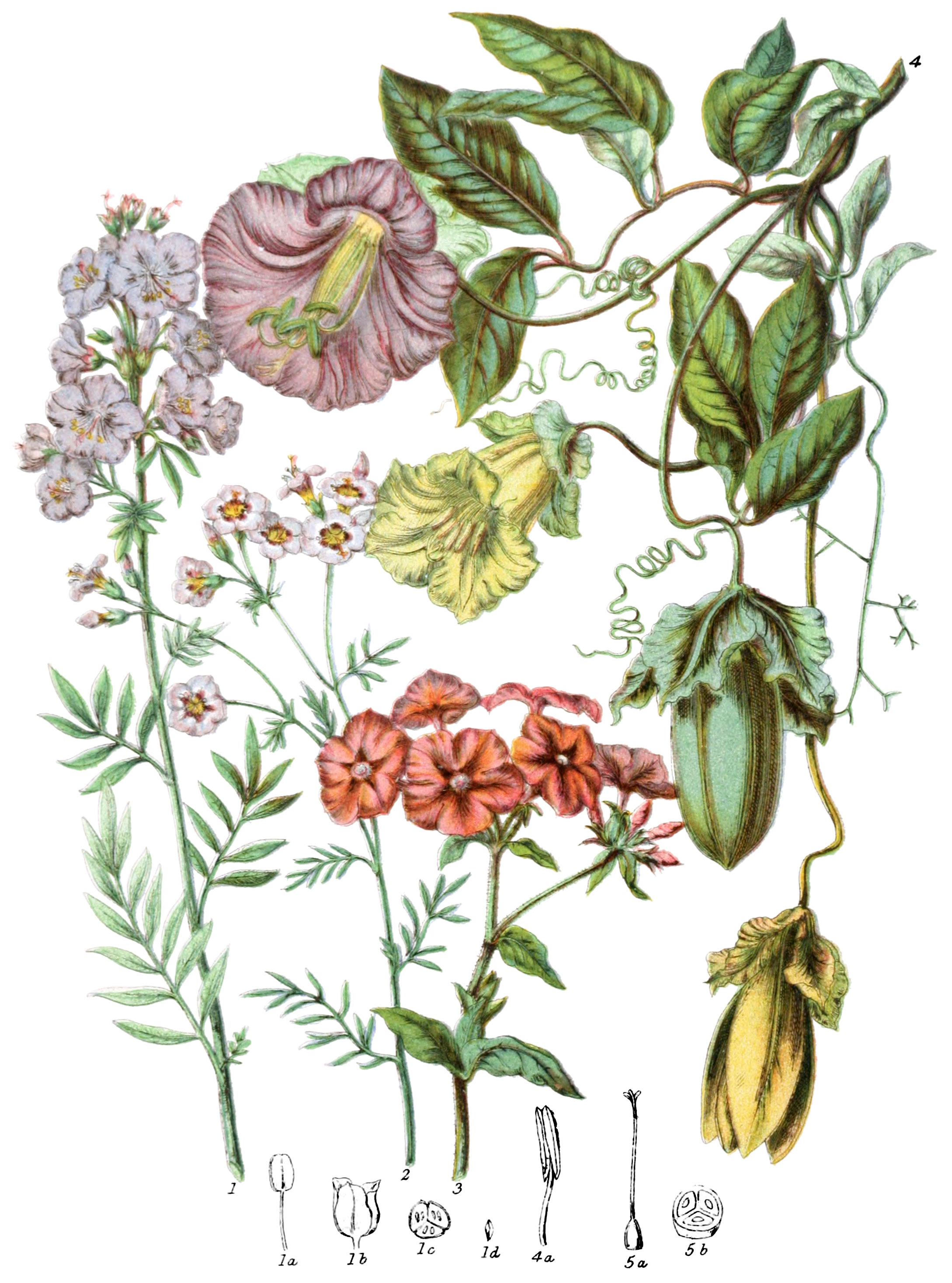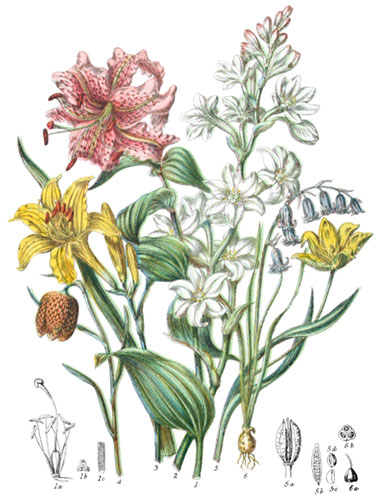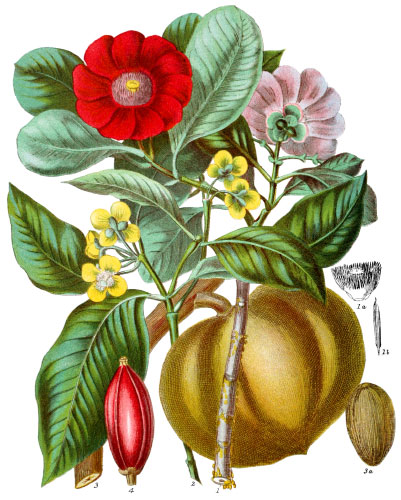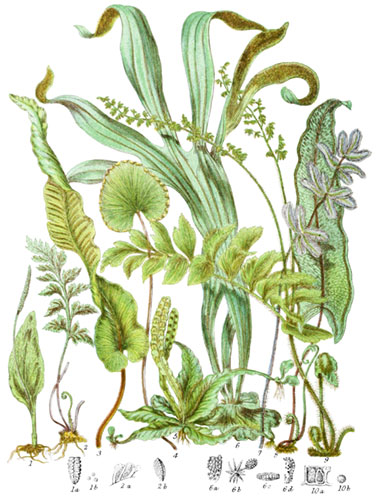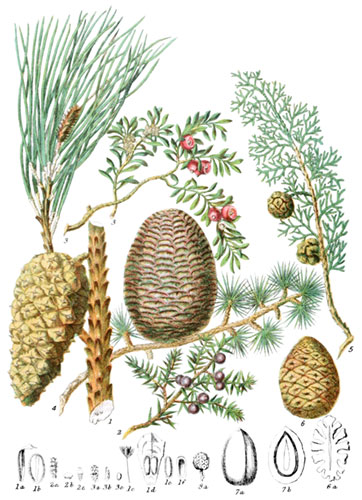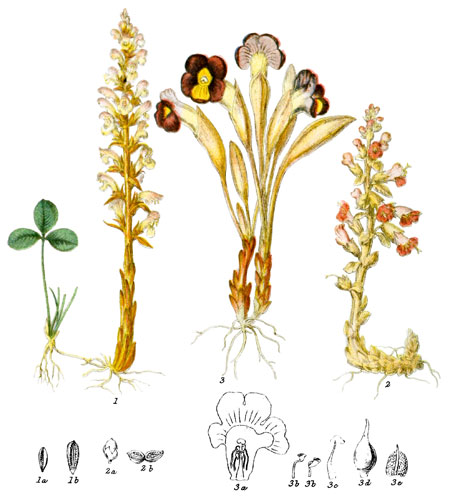Key characteristics
Herbaceious plants, some of which are climbing. The leaves are opposite, occasionally alternate, compound or simple. The flowers are generally in panicles, seldom solitary; the calyx is usually below the ovary, five-parted at the top, sometimes irregular, persistent. The corolla is regular, or nearly so, five-lobed. The stamens are five, inserted into the middle of the tube of the corolla, alternately with its segments; the pollen of the anthers is mostly blue. The ovary is above the calyx, three-celled, with few or many ovules; the style is simple, the stigma trifid. The capsule has three cells and three valves, which separate from the three-cornered central axis. The seeds are angular or oval, containing horny albumen; sometimes winged; often enveloped in a viscid substance full of entangled spiral threads.
This Tribe is connected with Convolvulaceæ by Cobæa: it has also affinity with Gentianaceæ, but is distinguished by the three-celled ovary.
These plants are mucilaginous and bitter.
Select plants in this order
Not all plants listed are illustrated and not all plants illustrated are listed.
- Polemonium was known to the ancients, and is said by Pliny to have derived its name from the circumstance of two kings disputing who had the honour of discovering its value. Whatever may have been the supposed efficacy formerly, it is now classed among the useless plants, although Polemonium cæruleum (1) is one of the prettiest of our native flowers. It grows chiefly in the north of England and south of Scotland; at Malham and Gordale, in Yorkshire, it is abundant, often as much as two feet high; in cottage gardens it is a common ornament, generally known by he Greek name Valerian, or Jacob’s Ladder; it has been found also on the Himalayas.
- P. reptans is a creeping species of North America; P. mexicanum belongs to Mexico.
- P. gracile reaches the northern limit of the tribe in Siberia, and it is also known in Japan.
- Gilia is a genus named after a Spanish botanist, introduced of late years from California and Chile. The leaves of all the species are extermely slender, and the flowers very delicate.
- G. tricolor (2) was first brought to England twenty years ago, and is now an established favourite in the garden.
- Phlox being derived from the Greek signifying flame, was probably at first applied to a different plant; the species now so called are natives of North America; they are of hardy nature and produce their bright flowers of various shades of purple late in autumn, when red or yellow flowers are more prevalent; they are consequently a pleasaing addition to the flower border, and help to maintain the due harmony of colour.
- P. paniculata and its white variety are old inhabitants of our gardens, well known formerly as Lychnidea. At the base of the slender curved tube is a store of honey, which bees extract, biting a hole in the tube. Several other species have been imported lately from North America, and though of more lowly growth, bear panicles of beautiful bright flowers of various shades of red and purple. This genus extends to Japan.
- Cobæa was named by Cavanilles in honour of Barnadez Cobo, a Spanish naturalist and author in the middle of the seventeenth century. It is an exception to the usual character of the tribe, being of a climbing habit, and possessing extraordinary power of growth in the length of branches; in the shelter of a conservatory, it has been observed to attain 200 feet in the course of the summer. The number of pores in a square inch of the under surface of the leaf is 20,000; the capacity for development in plants seems in some degree to be connected with the number of pores. Mistletoe has only 200 pores in the square inch, and never attains to any great length. Rhubarb has 40,000, and expands its leaf and stalk to an immense size.
- Cyanthus belongs entirely to lofty parts of the Himalaya.
- Collomia gracilis (5), an extremely viscit plant, is a native of North America, now frequent in English gardens.
- Leptosiphon, so named from the exceedingly slender tube of the corolla, is a late importation from California, in which country several genera of this tribe exist.
Locations
These herbaceous plants are most abundant in the Temperate latitudes of North and South America, more particularly in the North-west regions. A few only are natives of Europe and Asia. In the Tropics they are unknown.
Legend
- Polemonium cæruleum, Greek Valerian. England.
- Stamen.
- Capsule.
- Section of Capsule.
- Seed.
- Gilia tricolor, Three-coloured Gilia. California.
- Phlox Drummondii, Drummon’s Phlox. Texas.
- Cobæa scandens, Climbing Cobæa. Mexico.
- Stamen.
-
- Pistil of Collomia gracilis.
- Section of Ovary.
Explore more
Posters
Decorate your walls with colorful detailed posters based on Elizabeth Twining’s beautiful two-volume set from 1868.
Puzzles
Challenge yourself or someone else to assemble a puzzle of all 160 botanical illustrations.
